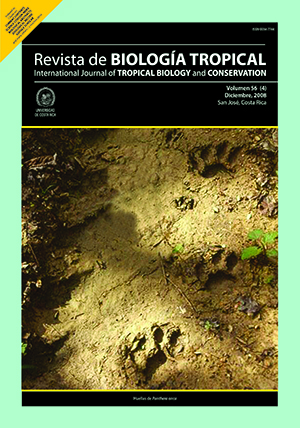Abstract
We examined soil water use patterns of four model plant associations established in the North Caribbean lowlands of Costa Rica by comparing the stable hydrogen isotope composition, dD, in xylem sap and in soil water at different depths, under rainy and dry conditions. Four 5-year-old model plant associations composed of 2 tree species (Hyeronima alchorneoides and Cedrela odorata) having different architecture and phenology were studied. Average tree height was 8.9 and 7.6 m, respectively. Each tree species was grown in monoculture and in polyculture with 2 perennial monocotyledons (Euterpe oleracea and Heliconia imbricata). Maximum rooting depth at the time of dD determination was ~ 2 m for almost all species. Most roots of all species were concentrated in the upper soil layers. Stomatal conductance to water vapor (gS) was higher in the deciduous C. odorata than in the evergreen H. alchorneoides; within each species, gS did not differ when the trees were grown in mono or in polyculture. During the rainy season, gradients in soil water dD were not observed. Average rainy season xylem sap dD did not differ among members of the plant combinations tested (-30 %), and was more similar to dD values of shallow soil water. Under dry conditions, volumetric soil water content declined from 50 to ~ 35%, and modest gradients in soil water dD were observed. Xylem sap dD obtained during dry conditions was significantly lower than rainy season values. Xylem sap dD of plants growing in the four associations varied between -9 and -22%, indicating that shallow water was predominantly absorbed during the dry period too. Differences in xylem sap dD of trees and monocots were also detected, but no significant patterns emerged. The results suggest that: a) the plant associations examined extracted water predominantly from shallow soil layers ( < 1 m), b) the natural isotopic variation in soil and plant water at the study site was low, and c) the plant mixes obtain water from more than a single soil layer simultaneously. Temporal factors were important in determining the competition and complementary relations observed among the trees and the perennial monocots. Under the prevailing environmental conditions, water use in these plant associations was determined largely by species-specific attributes such as biomass allocation to fine roots, phenology, and canopy architecture, and to a lesser extent by water limitations.##plugins.facebook.comentarios##

This work is licensed under a Creative Commons Attribution 4.0 International License.
Copyright (c) 2008 Revista de Biología Tropical
Downloads
Download data is not yet available.






